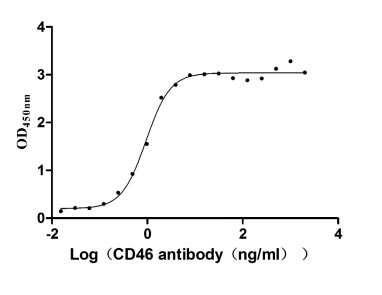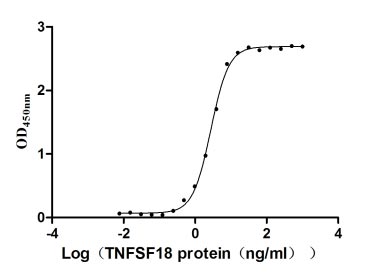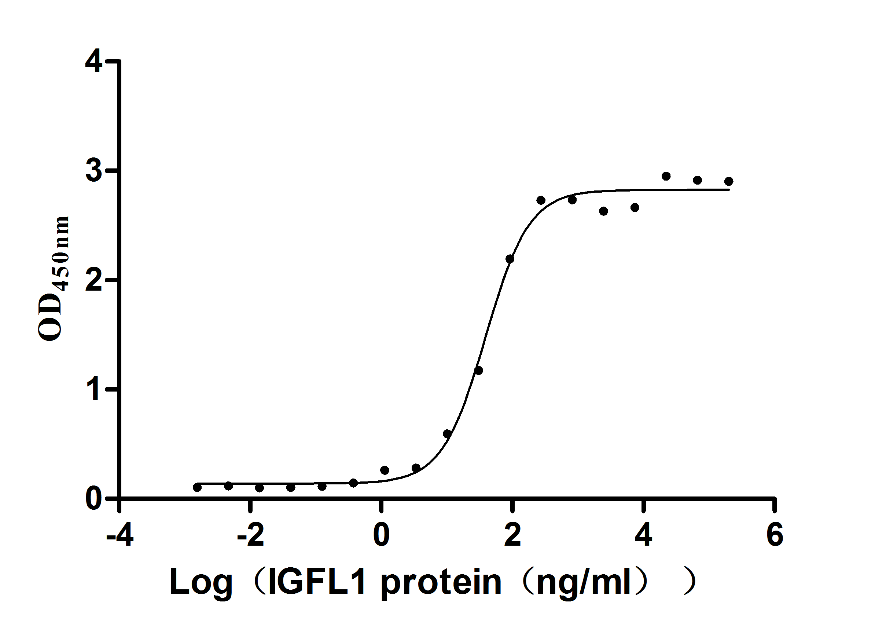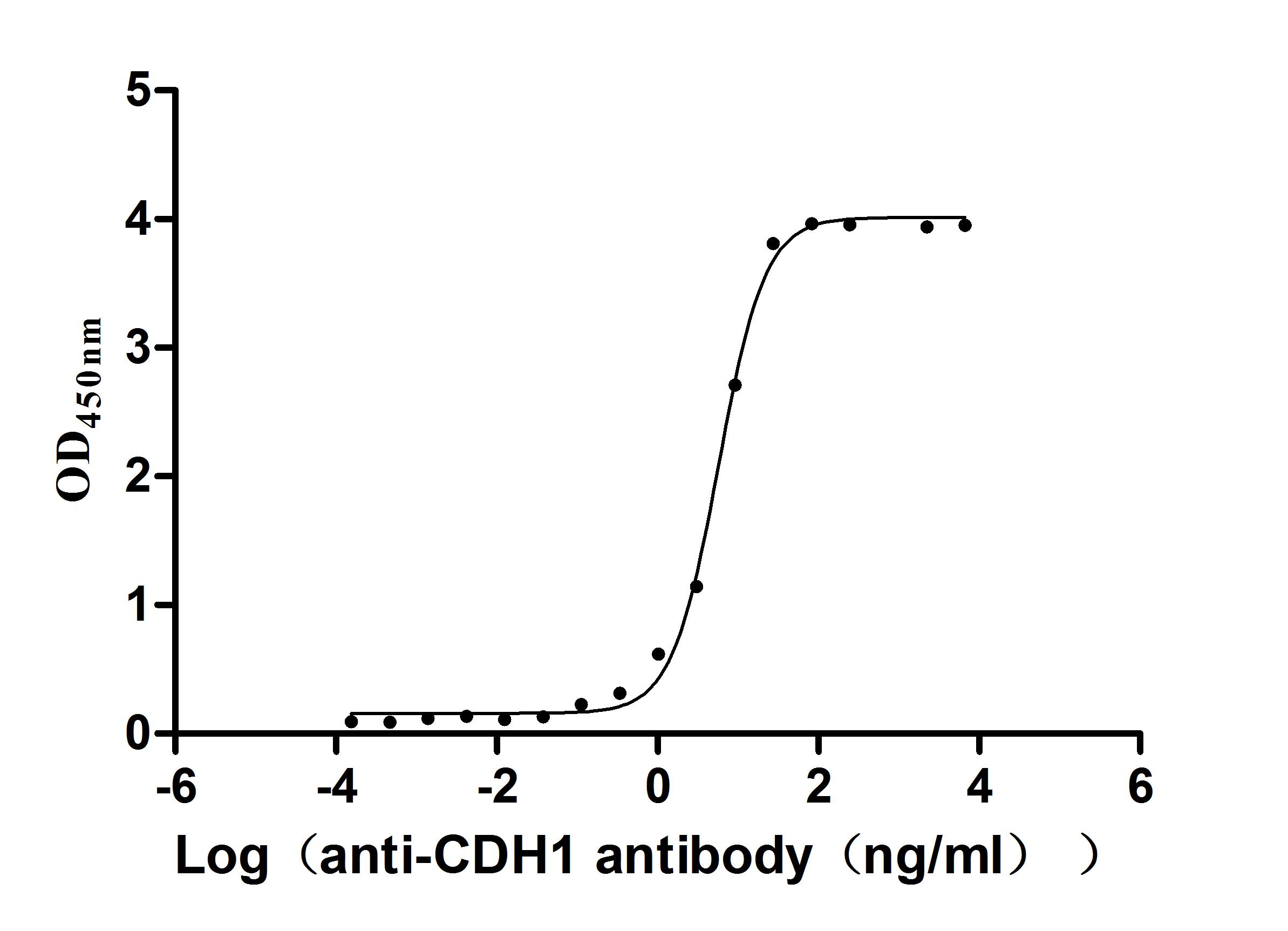Recombinant Human Hepatocyte growth factor receptor (MET), partial (Active)
Unavailable-
货号:CSB-AP003691HU
-
规格:¥576
-
图片:
-
其他:
产品详情
-
纯度:Greater than 95% as determined by SDS-PAGE.
-
内毒素:Less than 1.0 EU/μg as determined by LAL method.
-
生物活性:The ED50 as determined by its ability to bind Human HGF in functional ELISA is less than 10 ug/ml.
-
基因名:
-
Uniprot No.:
-
别名:AUTS9; c met; D249; Hepatocyte growth factor receptor; HGF; HGF receptor; HGF/SF receptor; HGFR; MET; Met proto oncogene; Met proto oncogene tyrosine kinase; MET proto oncogene; receptor tyrosine kinase; Met proto-oncogene (hepatocyte growth factor receptor); Met proto-oncogene; Met protooncogene; MET_HUMAN; Oncogene MET; Par4; Proto-oncogene c-Met; RCCP2; Scatter factor receptor; SF receptor; Tyrosine-protein kinase Met
-
种属:Homo sapiens (Human)
-
蛋白长度:Extracellular Domain
-
来源:Mammalian cell
-
分子量:128.4 kDa
-
表达区域:25-932aa
-
氨基酸序列ECKEALAKSEMNVNMKYQLPNFTAETPIQNVILHEHHIFLGATNYIYVLNEEDLQKVAEYKTGPVLEHPDCFPCQDCSSKANLSGGVWKDNINMALVVDTYYDDQLISCGSVNRGTCQRHVFPHNHTADIQSEVHCIFSPQIEEPSQCPDCVVSALGAKVLSSVKDRFINFFVGNTINSSYFPDHPLHSISVRRLKETKDGFMFLTDQSYIDVLPEFRDSYPIKYVHAFESNNFIYFLTVQRETLDAQTFHTRIIRFCSINSGLHSYMEMPLECILTEKRKKRSTKKEVFNILQAAYVSKPGAQLARQIGASLNDDILFGVFAQSKPDSAEPMDRSAMCAFPIKYVNDFFNKIVNKNNVRCLQHFYGPNHEHCFNRTLLRNSSGCEARRDEYRTEFTTALQRVDLFMGQFSEVLLTSISTFIKGDLTIANLGTSEGRFMQVVVSRSGPSTPHVNFLLDSHPVSPEVIVEHTLNQNGYTLVITGKKITKIPLNGLGCRHFQSCSQCLSAPPFVQCGWCHDKCVRSEECLSGTWTQQICLPAIYKVFPNSAPLEGGTRLTICGWDFGFRRNNKFDLKKTRVLLGNESCTLTLSESTMNTLKCTVGPAMNKHFNMSIIISNGHGTTQYSTFSYVDPVITSISPKYGPMAGGTLLTLTGNYLNSGNSRHISIGGKTCTLKSVSNSILECYTPAQTISTEFAVKLKIDLANRETSIFSYREDPIVYEIHPTKSFISGGSTITGVGKNLNSVSVPRMVINVHEAGRNFTVACQHRSNSEIICCTTPSLQQLNLQLPLKTKAFFMLDGILSKYFDLIYVHNPVFKPFEKPVMISMGNENVLEIKGNDIDPEAVKGEVLKVGNKSCENIHLHSEAVLCTVPNDLLKLNSELNIEWKQAISSTVLGKVIVQPDQNFT
-
蛋白标签:C-terminal hFc-tagged
-
产品提供形式:Liquid or Lyophilized powder
Note: We will preferentially ship the format that we have in stock, however, if you have any special requirement for the format, please remark your requirement when placing the order, we will prepare according to your demand. -
缓冲液:Lyophilized from a 0.2 μm filtered 1xPBS, pH 7.4
-
储存条件:Store at -20°C/-80°C upon receipt, aliquoting is necessary for mutiple use. Avoid repeated freeze-thaw cycles.
-
保质期:The shelf life is related to many factors, storage state, buffer ingredients, storage temperature and the stability of the protein itself.
Generally, the shelf life of liquid form is 6 months at -20°C/-80°C. The shelf life of lyophilized form is 12 months at -20°C/-80°C. -
货期:Basically, we can dispatch the products out in 1-3 working days after receiving your orders. Delivery time may differ from different purchasing way or location, please kindly consult your local distributors for specific delivery time.Note: All of our proteins are default shipped with normal blue ice packs, if you request to ship with dry ice, please communicate with us in advance and extra fees will be charged.
-
Datasheet & COA:Please contact us to get it.
相关产品
靶点详情
-
功能:Receptor tyrosine kinase that transduces signals from the extracellular matrix into the cytoplasm by binding to hepatocyte growth factor/HGF ligand. Regulates many physiological processes including proliferation, scattering, morphogenesis and survival. Ligand binding at the cell surface induces autophosphorylation of MET on its intracellular domain that provides docking sites for downstream signaling molecules. Following activation by ligand, interacts with the PI3-kinase subunit PIK3R1, PLCG1, SRC, GRB2, STAT3 or the adapter GAB1. Recruitment of these downstream effectors by MET leads to the activation of several signaling cascades including the RAS-ERK, PI3 kinase-AKT, or PLCgamma-PKC. The RAS-ERK activation is associated with the morphogenetic effects while PI3K/AKT coordinates prosurvival effects. During embryonic development, MET signaling plays a role in gastrulation, development and migration of muscles and neuronal precursors, angiogenesis and kidney formation. In adults, participates in wound healing as well as organ regeneration and tissue remodeling. Promotes also differentiation and proliferation of hematopoietic cells. May regulate cortical bone osteogenesis.; (Microbial infection) Acts as a receptor for Listeria monocytogenes internalin InlB, mediating entry of the pathogen into cells.
-
基因功能参考文献:
- the miR-19a/c-Met pathway plays a critical role in acquired resistance to gefitinib and that the manipulation of miR-19a might provide a therapeutic strategy for overcoming acquired gefitinib resistance. PMID: 28592790
- The expression of C-Met and HER2 protein in lung adenocarcinoma is highly correlated, and whether it is synergistic in the targeted therapy of lung adenocarcinoma deserves further study. PMID: 29400000
- MET overexpression was more frequently found in high grade myxofibrosarcoma and the epithelioid variant. Chromosome 7 polysomy, rather than MET gene regional amplification, might account for the overexpression. of MET protein. PMID: 30126419
- miR-449a suppresses hepatocellular carcinoma tumorigenesis by down-regulating activity in the c-Met/ERK pathway. PMID: 30108016
- We found MET amplifications in two cases of endometrial clear-cell carcinoma with mixed features. PMID: 29633423
- Regarding gene mutation abundance, NGS enables the detection of low-abundant ctDNA in blood based on ultra-deep sequencing, and our patient benefited from crizotinib despite the low abundance of MET exon 14 skipping. These data indicate that we can choose targeted therapy despite the low abundance of gene mutations. PMID: 29110851
- The interplay of dual MET/HER2 overexpression in the AKT and ERK pathways for esophageal cancer is described. Therefore, combination therapy could be a novel strategy for EAC with amplification of both MET and HER2. PMID: 29223420
- MET inactivation in the context of the BRAF-activating mutation is driven through a negative feedback loop involving inactivation of PP2A phosphatase, which in turn leads to phosphorylation on MET inhibitory Ser985. PMID: 30224486
- MET Exon 14 Skipping Mutations in Non-small Cell Lung Cancer PMID: 30037377
- MET activation, by either METex14 mutations or amplification, is characteristic of a subset of early stage NSCLCs and may coexist with ERBB2 amplification. PMID: 29139039
- Results demonstrate that serum level of miR-658 is significantly lower in the NM group than in the DM group. Meanwhile, the levels of PAX3 and MET are lower in the NM group than in the DM group too. Both overexpression and silence of miR-658 significantly up-regulate or down-regulate the levels of PAX3 and MET in gastric cell lines. PMID: 29630524
- MiR-206 inhibits the development of epithelial ovarian cancer cell by directly targeting c-Met and inhibiting the c-Met/AKT/mTOR signaling pathway. PMID: 29807226
- These results suggest that gastric cancer progression is not associated with a unique signaling pathway and that a feedback loop may exist between the HGF/c-Met and Notch1 signaling pathways, which may result in therapeutic resistance. PMID: 29781036
- Comparative analysis revealed a strong association between MET expression and MET amplification (85% concurrence) in primary stomach tumors and matched liver metastasis. Survival analyses revealed that both MET amplification and MET overexpression were prognostic of poor outcomes. PMID: 29790169
- High c-met expression is associated with oral squamous cell carcinoma. PMID: 29286169
- FOXO1 serves as an important linker between HER2 and MET signaling pathways through negative crosstalks and is a key regulator of the acquired lapatinib resistance in HER2-positive GC cells. PMID: 28343375
- analysis of how the cMET blockade augments radiation therapy in patients with NF2 PMID: 29440379
- these findings highlight the relevance of cross-species protein interactions between murine feeder cells and human epithelial cells in 3T3-J2 co-culture and demonstrate that STAT6 phosphorylation occurs in response to MET activation in epithelial cells. However, STAT6 nuclear translocation does not occur in response to HGF, precluding the transcriptional activity of STAT6. PMID: 29771943
- c-Met-activated Mesenchymal Stem Cells (MSC) pre-exposed to hypoxia interact with PrPC at the site of ischemic injury to increase the efficiency of MSC transplantation. PMID: 29705776
- A novel G-quadruplex motif formed in the Human MET promoter region. PMID: 29054971
- a METex14 del mutation-positive NSCLC patient who responded to crizotinib but later relapsed, demonstrated a mixed response to glesatinib including reduction in size of a MET Y1230H mutation-positive liver metastasis and concurrent loss of detection of this mutation in plasma DNA. Together, these data demonstrate that glesatinib exhibits a distinct mechanism of target inhibition and can overcome resistance to PMID: 28765324
- This study demonstrates that simultaneous inhibition of c-Met and Src signaling in MD-MSCs triggers apoptosis and reveals vulnerable pathways that could be exploited to develop NF2 therapies. PMID: 28775147
- prolonged treatment of single HGF/c-Met or Hh inhibitor leads to resistance to these single inhibitors, likely because the single c-Met treatment leads to enhanced expression of Shh, and vice versa. Targeting both the HGF/c-Met and Hh pathways simultaneously overcame the resistance to the single-inhibitor treatment and led to a more potent antitumor effect in combination with the chemotherapy treatment. PMID: 28864680
- We identified unique and tumor-specific tyrosine phosphorylation rewiring in tumors resistant to treatment with the irreversible third-generation EGFR-inhibitor, osimertinib, or the novel dual-targeting EGFR/Met antibody, JNJ-61186372. PMID: 28830985
- TGF-beta negatively controls the HGF/c-MET pathway by regulating of stemness in glioblastoma. PMID: 29238047
- The preclinical efficacy and safety data provide a clear rationale for the ongoing clinical studies of Sym015 in patients with MET-amplified tumors. PMID: 28679766
- High MET expression is associated with malignant pleural mesothelioma. PMID: 28560410
- the results of real-time PCR and western blotting revealed that Huaier extract decreased p65 and c-Met expression and increased IkappaBalpha expression, while paclitaxel increased p65 expression and reduced IkappaBalpha and c-Met expression.The molecular mechanisms may be involved in the inhibition of the NF-kappaB pathway and c-Met expression PMID: 29039556
- Data found that the expression of c-Met was significantly increased in human oral squamous cell carcinoma (OSCC) tissues than in normal mucosa adjacent to the tumor, but was not correlated with clinicopathological parameters. Also, further findings indicated the potential role of c-Met in the progression of OSCC. PMID: 29115556
- Our data show that S49076 exerts its cytotoxic activity at low doses on MET-dependent cells through MET inhibition, whereas it inhibits growth of MET-independent cells at higher but clinically relevant doses by targeting Aurora B PMID: 28619752
- MET expression was shown to be significantly reduced in the superior temporal gyrus cortex of autism spectrum disorders individuals. PMID: 28322981
- In SCCHN, immunohistochemical overexpression of c-MET above cut-off levels III and particularly II was associated with inferior survival outcomes and advanced disease PMID: 29103754
- Here we present a case series of three such patients who achieved were cMET amplified and showed partial response on Crizotinib PMID: 29199685
- c-Met/beta1 integrin complex whose ligand-independent cross-activation and robust affinity for fibronectin drives invasive oncologic processes. PMID: 28973887
- tivantinib did not suppress MET signaling, and selective MET inhibitors demonstrated an antiproliferative effect only in MHCC97H, the unique cell line displaying MET gene amplification. HCC tumors with high expression of cell proliferation genes defined a group of patients with poor survival. PMID: 28246274
- Studies show that MET mutations have been found in cancer of unknown primary origin (CUP) being clustered to the SEMA and TK domain of the receptor. The biomechanical properties of MET mutants might trigger the hyper-invasive phenotype associated to CUP. [review] PMID: 29037604
- Data show that Kruppel like factor 4 (KLF4) was overexpressed in met proto-oncogene protein (c-Met)-overexpressing non-small-cell lung cancer (NSCLC) cells and tissues. PMID: 29624806
- SOCS1 attenuates migration and invasion properties of hepatocellular carcinoma cells at least partly via modulation of MET-mediated epithelial-mesenchymal transition, and controls invasive tumor growth. PMID: 29085209
- The s reconfirmed EGFR mutation as a strong predictive marker of Non-Small-Cell Lung Cancer. However, c-MET positivity was not associated with response or progression-free survival, although c-MET overexpression correlated with some clinical characteristics. PMID: 29502124
- findings show oncogene E5 is primarily responsible for Met upregulation; E5-induced Met contributes motility of HPV-containing cells; these studies show a new role for E5 in epithelial-stromal interactions, with implications for cancer development PMID: 29609071
- EGFR T790M mutation and cMET amplification are main mechanisms leading to EGFR TKI resistance in lung adenocarcinoma. PMID: 29616327
- MET activation is associated with drug resistance in chronic myeloid leukemia. PMID: 28418880
- High glucose activated Met receptor in HK2 cells independently of HGF, via induction of integrin a5b1 and downstream signaling. This mode of Met activation was associated with tubular cell damage and apoptosis and it may represent a novel pathogenic mechanism and a treatment target in diabetic nephropathy. PMID: 28819999
- The purpose of this study was to explore gene copy number (GCN) variation of EGFR, HER2, c-MYC, and MET in patients with primary colorectal cancer. PMID: 28764718
- HGF/c-MET pathway mediates VEGFR inhibitor resistance and vascular remodeling in NSCLC. PMID: 28559461
- Because c-Met is strongly associated with pathological grade, stage and disease-specific survival, c-Met levels may have potential to predict patient prognosis and to guide clinical diagnosis and treatment of patients with renal cell carcinoma PMID: 28427859
- miR-1 is downregulated in ovarian cancer tissues, and may play a tumor suppressive role by inhibiting c-Met expression and its effects on the regulation of cell proliferation, migration and invasion PMID: 28698064
- Proto-oncogene proteins c-met (MET) mutations Y1248H and D1246N confer resistance in vitro and in vivo. PMID: 28396313
- MET overexpression is found in 23.8% of surgically resected NSCLC. MET amplification prevails in 4.6% and is associated with MET overexpression. Both have no influence on prognosis. PMID: 28838386
- study highlights the role of tissue differentiation on pathological response to neoadjuvant chemotherapy in gastric cancer and shows no impact between FOXP3, HER2 and MET expression in terms of tumor regression grading PMID: 29696715
显示更多
收起更多
-
相关疾病:Hepatocellular carcinoma (HCC); Renal cell carcinoma papillary (RCCP); Deafness, autosomal recessive, 97 (DFNB97); Osteofibrous dysplasia (OSFD)
-
亚细胞定位:Membrane; Single-pass type I membrane protein.; [Isoform 3]: Secreted.
-
蛋白家族:Protein kinase superfamily, Tyr protein kinase family
-
组织特异性:Expressed in normal hepatocytes as well as in epithelial cells lining the stomach, the small and the large intestine. Found also in basal keratinocytes of esophagus and skin. High levels are found in liver, gastrointestinal tract, thyroid and kidney. Also
-
数据库链接:
HGNC: 7029
OMIM: 114550
KEGG: hsa:4233
STRING: 9606.ENSP00000317272
UniGene: Hs.132966
Most popular with customers
-
Recombinant Human Membrane cofactor protein (CD46), partial (Active)
Express system: Mammalian cell
Species: Homo sapiens (Human)
-
Recombinant Human Tumor necrosis factor ligand superfamily member 18 (TNFSF18), partial (Active)
Express system: Mammalian cell
Species: Homo sapiens (Human)
-
Recombinant Human IGF-like family receptor 1 (IGFLR1), partial (Active)
Express system: Mammalian cell
Species: Homo sapiens (Human)
-
Recombinant Dog Angiopoietin-2 (ANGPT2) (Active)
Express system: Mammalian cell
Species: Canis lupus familiaris (Dog) (Canis familiaris)
-
Recombinant Human Gastric inhibitory polypeptide receptor(GIPR),partial (Active)
Express system: Mammalian cell
Species: Homo sapiens (Human)
-
Recombinant Human Cadherin-1(CDH1),partial (Active)
Express system: Mammalian cell
Species: Homo sapiens (Human)
-
Recombinant Human C-C chemokine receptor type 5 (CCR5)-VLPs
Express system: Mammalian cell
Species: Homo sapiens (Human)




















